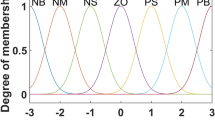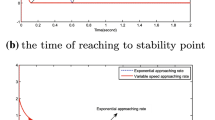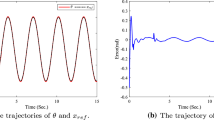Abstract
To develop a high-performance permanent magnet linear servo system, a novel intelligent second-order complementary sliding mode control (ISOCSMC) method is proposed in this paper. First, the mathematical model of permanent magnet linear synchronous motor (PMLSM) with uncertainties is established. To conquer the uncertainties and reduce chattering, a second-order complementary sliding mode control (SOCSMC) with fast convergence and global robustness is developed. However, because the value of lumped uncertainty is difficult to obtain in advance and cannot be adjusted automatically, an intelligent control system using recurrent Gegenbauer fuzzy neural network (RGFNN) based on improved whale optimization algorithm (IWOA) is proposed to further improve the servo performance. RGFNN acts as an estimator to approximate the lumped uncertainty, and IWOA is used to convergence of the output tracking error and improve the convergence speed of RGFNN. Finally, the experimental results demonstrate the proposed controller exhibits high tracking accuracy and strong robustness against the parameter variations and load disturbances in comparison with the recently reported control strategies.









Similar content being viewed by others
References
Song B, Zheng S, Tang X et al (2017) Fractional order modeling and nonlinear fractional order pi-type control for PMLSM system. Asian J Control 1(2):99–108
Chen SY, Liu TS (2017) Intelligent tracking control of a PMLSM using self-evolving probabilistic fuzzy neural network. IET Electr Power Appl 11(6):1043–1054
El-Sousy F and Abuhasel KA (2018) Intelligent adaptive dynamic surface control system with recurrent wavelet Elman neural networks for DSP-based induction motor servo drives. IEEE Trans Ind Appl. https://doi.org/10.1109/TIA.2018.2876642
Li T, Sun X, Lei G et al (2022) Finite-control-set model predictive control of permanent magnet synchronous motor drive systems-an overview. IEEE/CAA J Autom Sinica (JAS) 9(12):2087–2105
Sun X, Li T, Zhu Z et al (2021) Speed sensorless model predictive current control based on finite position set for PMSHM drives. IEEE Trans Transp Electrific 7(4):2743–2752
Nguyen TH, Nguyen TT, Le KM (2023) An adaptive backstepping sliding-mode control for improving position tracking of a permanent-magnet synchronous motor with a nonlinear disturbance observer. IEEE Access 11:19173–19185
Nguyen TH, Nguyen TT, Nguyen VQ et al (2022) An adaptive sliding-mode controller with a modified reduced-order proportional integral observer for speed regulation of a permanent magnet synchronous motor. IEEE Trans Industr Electron 69(7):7181–7191
Zheng J, Wang H, Man Z et al (2015) Robust motion control of a linear motor positioner using fast nonsingular terminal sliding mode. IEEE/ASME Trans Mechatron 20(4):1743–1752
Shao K, Zheng J, Huang K et al (2020) Finite-time control of a linear motor positioner using adaptive recursive terminal sliding mode. IEEE Trans Industr Electron 67(8):6659–6668
Zhang X, Chen Z, Pan J et al (2006) Fixed boundary layer sliding mode control of permanent magnet linear synchronous motor. Proc CSEE 26(22):115–121
Song Q, Li Y, Jia C (2018) A novel direct torque control method based on asymmetric boundary layer sliding mode control for PMSM. Energies 11(3):657
Su JP, Wang CC (2002) Complementary sliding control of nonlinear systems. Int J Control 75(5):360–368
Lin FJ, Hung YC, Ruan KC (2014) An intelligent second-order sliding-mode control for an electric power steering system using a wavelet fuzzy neural network. IEEE Trans Fuzzy Syst 22(6):1598–1611
Lin FJ, Chen SG and Hsu CW (2018) Intelligent backstepping control using recurrent feature selection fuzzy neural network for synchronous reluctance motor position servo drive system. IEEE Trans Fuzzy Syst. https://doi.org/10.1109/TFUZZ.2018.2858749
Lin FJ, Chen SY, Huang MS (2011) Adaptive complementary sliding-mode control for thrust active magnetic bearing system. Control Eng Pract 19:711–722
Lin CH (2017) Nonlinear backstepping control design of LSM drive system using adaptive modified recurrent Laguerre orthogonal polynomial neural network. Int J Control Autom Syst 15(2):905–917
Jin Z, Sun X, Lei G et al (2022) Sliding mode direct torque control of SPMSMs based on a hybrid wolf optimization algorithm. IEEE Trans Industr Electron 69(5):4534–4544
Miejalili S, Lewis A (2016) The whale optimization algorithm. Adv Eng Softw 95:51–67
Aljarah I, Faris H, Mirjalili S (2018) Optimizing connection weights in neural networks using the whale optimization algorithm. Soft Comput 28(1):1–15
Qais MH, Hasanien HM, Alghuwainem S (2020) Whale optimization algorithm-based Sugeno fuzzy logic controller for fault ride-through improvement of grid-connected variable speed wind generators. Eng Appl Artif Intell 87:1–13
Rui Y, Wang M, Li L et al (2020) Robust predictive current control of PMLSM with extended state modeling based Kalman filter: for time-varying disturbance rejection. IEEE Trans Power Electron 35(2):2208–2221
Xie Y (2018) Second order complementary sliding mode speed control of permanent magnet synchronous motor. Fuzhou University
Lin FJ, Huang MS, Chen SG et al (2019) Adaptive backstepping control for synchronous reluctance motor based on intelligent current angle control. IEEE Trans Power Electron 34(12):7465–7479
Lin CH (2016) Blend modified recurrent Gegenbauer orthogonal polynomial neural network control for six-phase copper rotor induction motor servo-driven continuously variable transmission system using amended artificial bee colony optimization. Trans Inst Meas Control 39(6):1–30
Nguyen TT, Tran HN, Nguyen TH et al (2023) Recurrent neural network-based robust adaptive model predictive speed control for PMSM with parameter mismatch. IEEE Trans Industr Electron 70(6):6219–6228
Loucif F, Kechida S, Abdennour S (2020) Whale optimizer algorithm to tune PID controller for the trajectory tracking control of robot manipulator. J Braz Soc Mech Sci Eng 42(1):1–11
Acknowledgements
The author would like to acknowledge the financial supports of the Liaoning Provincial Doctoral Research Start-up Foundation Plan, under Grant 2022-BS-177.
Author information
Authors and Affiliations
Contributions
This manuscript was written by Hongyan Jin, who independently completed the research design and data analysis and wrote the article. Yunwei Gong proofread all drafts, while Ximei Zhao provided the first guidance and objectively reviewed the article. All authors have contributed to further revisions of this article. Finally, all authors made contributions to the writing of the manuscript, providing constructive suggestions and improvement suggestions to ensure that the article can accurately express complex research results.
Corresponding author
Ethics declarations
Conflict of interest
The authors declare that there is no competing financial interest or personal relationship that could have appeared to influence the work reported in this paper.
Additional information
Publisher's Note
Springer Nature remains neutral with regard to jurisdictional claims in published maps and institutional affiliations.
Rights and permissions
Springer Nature or its licensor (e.g. a society or other partner) holds exclusive rights to this article under a publishing agreement with the author(s) or other rightsholder(s); author self-archiving of the accepted manuscript version of this article is solely governed by the terms of such publishing agreement and applicable law.
About this article
Cite this article
Jin, H., Gong, Y. & Zhao, X. High precision tracking control for linear servo system based on intelligent second-order complementary sliding mode. Electr Eng 106, 1105–1120 (2024). https://doi.org/10.1007/s00202-023-02038-4
Received:
Accepted:
Published:
Issue Date:
DOI: https://doi.org/10.1007/s00202-023-02038-4




